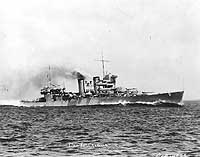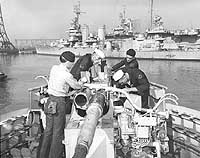
USS Tuscaloosa, a 9975-ton New Orleans class heavy cruiser, was built at Camden, New Jersey, and commissioned in August 1934. After a shakedown cruise to Argentina and Uruguay and post-shakedown overhaul, she went to the Pacific in April 1935, spending nearly four years there taking part in U.S. Fleet exercises and other activities. In January 1939 Tuscaloosa came back to the Atlantic area for Fleet Problem XX, steamed around South America during April-June, and carried President Franklin D. Roosevelt on a cruise off New England and eastern Canada in August. With the outbreak of the European war in September 1939, she began Neutrality Patrol operations. These included shadowing the German passenger liner Columbus in December, and rescuing that ship's survivors after she was scuttled.
Tuscaloosa continued her Atlantic area Neutrality Patrols in 1940 and 1941 and also took part in exercises. In February and December 1940, she hosted President Roosevelt on cruises to the west coast of South America and to the West Indies. Late in that year, she transported retired Admiral William D. Leahy to his new post as ambassador to France. As relations with Germany soured in 1941, Tuscaloosa partcipated in the Atlantic Charter conference in August and in "short of war" operations in the North Atlantic. She stayed in that area after war formally began in December and in April-September 1942 worked with the British Home Fleet in the waters between Iceland and the northern Soviet Union.
In November 1942, Tuscaloosa engaged French forces during the invasion of Morocco. She spent 1943 and the first part of 1944 on convoy, patrol and training duties in the North Atlantic. In June 1944, the cruiser supported the Normandy invasion, using her eight-inch guns to bombard German positions there and at Cherbourg. Tuscaloosa also took part in the invasion of Southern France in August.
With her Atlantic area assignments concluded, Tuscaloosa was transferred to the Pacific, where her big guns bombarded the Japanese during the Iwo Jima invasion in February 1945 and the Okinawa operation in March-June. Following Japan's surrender, she covered occupation efforts along the China and Korean coasts, work that lasted from late August until November 1945. Tuscaloosa's last active service was performed transporting service personnel home from the southern Pacific. In early February 1946, the veteran cruiser passed through the Panama Canal and steamed north to the Philadelphia Navy Yard, where she was soon decommissioned. Following thirteen years in the Atlantic Reserve Fleet, USS Tuscaloosa was stricken from the Navy list in March 1959. She was sold for scrapping a few months later.
This page features selected views concerning USS Tuscaloosa (CA-37).
| If you want higher resolution reproductions than the digital images presented here, see: "How to Obtain Photographic Reproductions." |
Click on the small photograph to prompt a larger view of the same image.
|
Photo #: 19-N-14733 USS Tuscaloosa (CA-37) Steaming at high speed, probably during trials in 1934. Photograph from the Bureau of Ships Collection in the U.S. National Archives. Online Image: 88KB; 740 x 605 pixels Reproductions of this image may also be available through the National Archives photographic reproduction system. |
 |
|
Photo #: 80-G-414458 USS Tuscaloosa (CA-37) At sea on 23 August 1935. Official U.S. Navy Photograph, now in the collections of the National Archives. Online Image: 92KB; 740 x 600 pixels Reproductions of this image may also be available through the National Archives photographic reproduction system. |
 |
|
Photo #: 80-G-12018 USS Tuscaloosa (CA-37) Moored in Scapa Flow, April 1942, while she was operating with the British Home Fleet. The British heavy cruiser London is in the background. Official U.S. Navy Photograph, now in the collections of the National Archives. Online Image: 123KB; 740 x 605 pixels Reproductions of this image may also be available through the National Archives photographic reproduction system. |
 |
|
Photo #: NH 97938 USS Tuscaloosa (CA-37) Underway on 7 October 1942. Official U.S. Navy Photograph, from the collections of the Naval Historical Center. Online Image: 63KB; 740 x 560 pixels |
 |
|
Photo #: NH 97939 USS Tuscaloosa (CA-37) Off the Philadelphia Navy Yard, Pennsylvania, 10 November 1944. She is wearing camouflage Measure 32, Design 13d. Official U.S. Navy Photograph, from the collections of the Naval Historical Center. Online Image: 70KB; 740 x 610 pixels |
 |
|
Photo #: NH 50850 USS Tuscaloosa (CA-37) Steams through heavy seas while en route to the Bahamas with President Franklin D. Roosevelt embarked, probably in December 1940. Photographed from the bridge, with her forward eight-inch gun turrets in the foreground. U.S. Naval Historical Center Photograph. Online Image: 95KB; 740 x 610 pixels |
 |
|
Photo #: NH 50855 USS Tuscaloosa (CA-37) Ship's Chief Petty Officers pose with President Franklin D. Roosevelt, during one of his cruises on board her in 1940. Note the president's deck fishing arrangement. U.S. Naval Historical Center Photograph. Online Image: 105KB; 740 x 595 pixels |
 |
|
Photo #: SC 114847 President Franklin D. Roosevelt And his Naval Aide, Captain Daniel J. Callaghan, taking the salute of a composite Battalion of the 14th Infantry at Gatun Locks, Panama Canal Zone, as they were disembarking from USS Tuscaloosa (CA-37) on 18 February 1940. Photograph from the Army Signal Corps Collection in the U.S. National Archives. Online Image: 119KB; 590 x 765 pixels Reproductions of this image may also be available through the National Archives photographic reproduction system. |
 |
|
Photo #: NH 47007 Convoy to Iceland, September 1941 USS Tuscaloosa (CA-37) hoists in a Curtiss SOC scout-observation plane after a patrol. View looks aft on the cruiser's starboard side, with midships' 5"/25 guns in the foreground. Another SOC is resting on the starboard catapult. U.S. Naval Historical Center Photograph. Online Image: 83KB; 740 x 545 pixels |
 |
|
Photo #: NH 96030 North African Invasion, November 1942 USS Tuscaloosa (CA-37) fires her eight-inch main battery at French forces, during action off Casablanca, Morocco, circa 8 November 1942. Collection of Commodore Norman C. Gillette, USN. U.S. Naval Historical Center Photograph. Online Image: 68KB; 740 x 600 pixels |
 |
|
Photo #: 80-G-309132 Iwo Jima Invasion, February 1945 USS Tuscaloosa (CA-37) signals with a blinker lamp, during a rainy dusk off Iwo Jima, 16 February 1945. Photographed from USS Texas (BB-35). Official U.S. Navy Photograph, now in the collections of the National Archives. Online Image: 89KB; 740 x 610 pixels Reproductions of this image may also be available through the National Archives photographic reproduction system. |
 |
|
Photo #: 80-G-708174 Barroso (Brazilian Light Cruiser, 1951) Brazilian Sailors working on one of the ship's 40mm twin gun mounts, at the Philadelphia Navy Yard, Pennsylvania, 27 March 1951. Previously USS Philadelphia (CL-41), transferred to Brazil in January 1951, Barroso was then undergoing a pre-commissioning overhaul. USS Tuscaloosa (CA-37) and an escort aircraft carrier are laid up in the background. Official U.S. Navy Photograph, now in the collections of the National Archives. Online Image: 118KB; 740 x 610 pixels Reproductions of this image may also be available through the National Archives photographic reproduction system. |
 |
| If you want higher resolution reproductions than the digital images presented here, see: "How to Obtain Photographic Reproductions." |
Page made 16 April 2002
Link added 31 December 2006